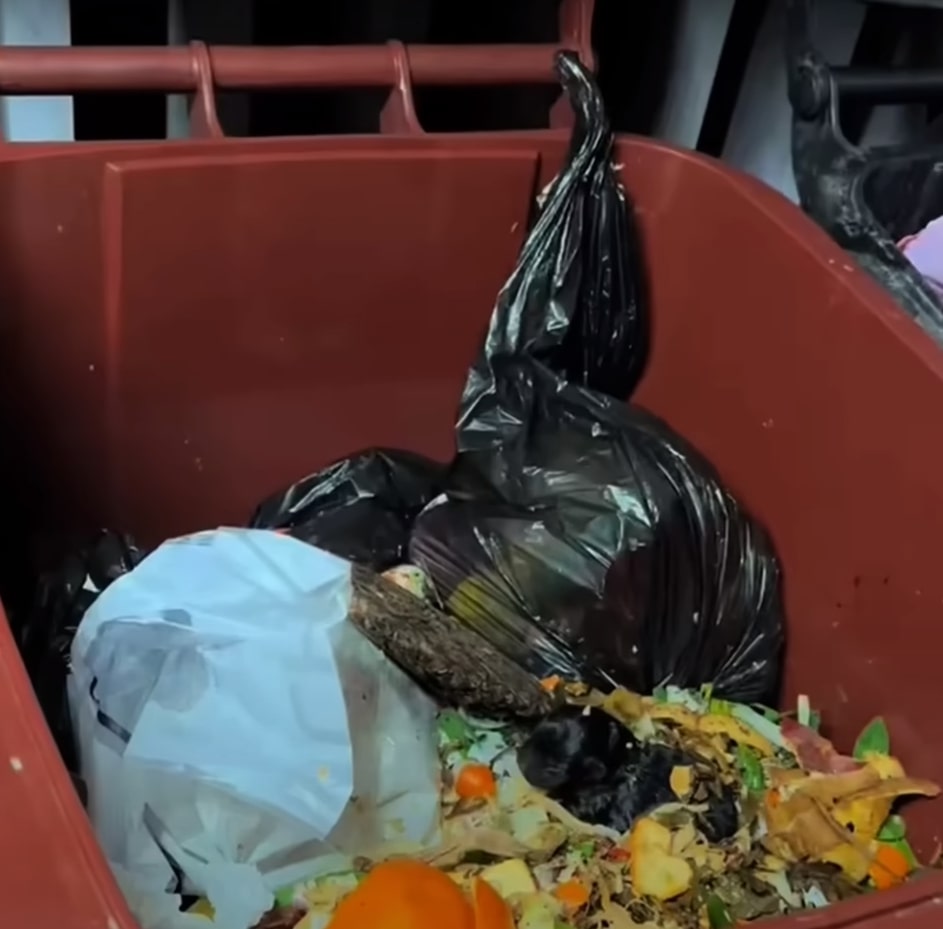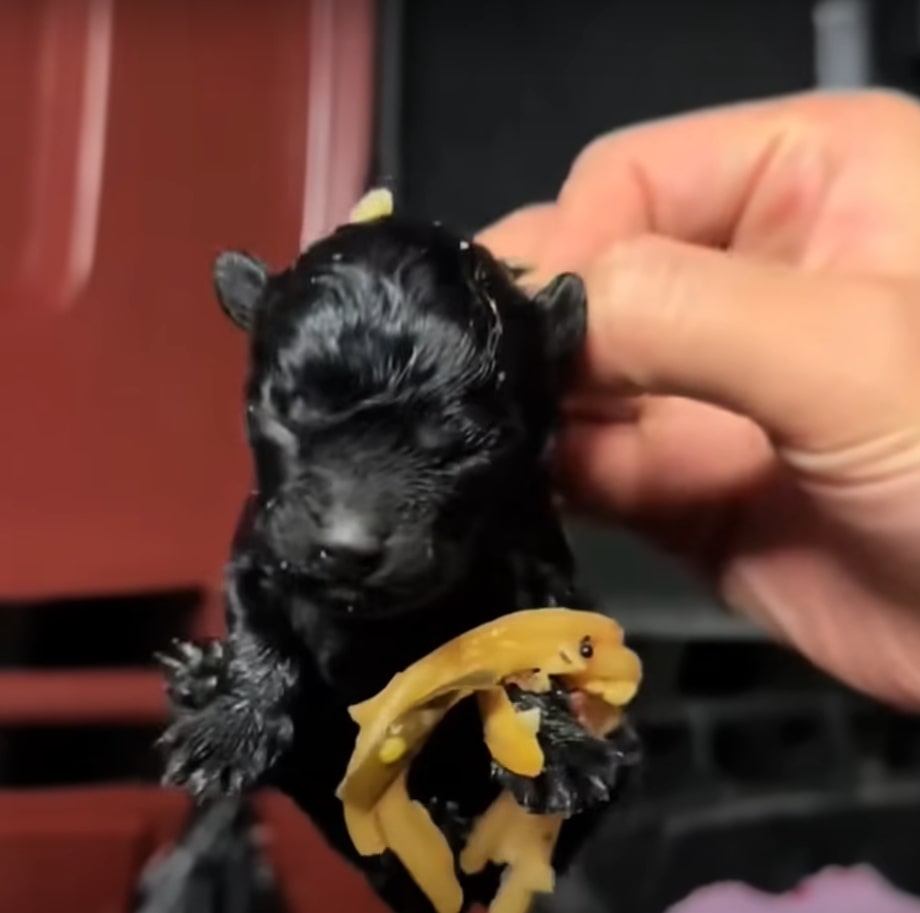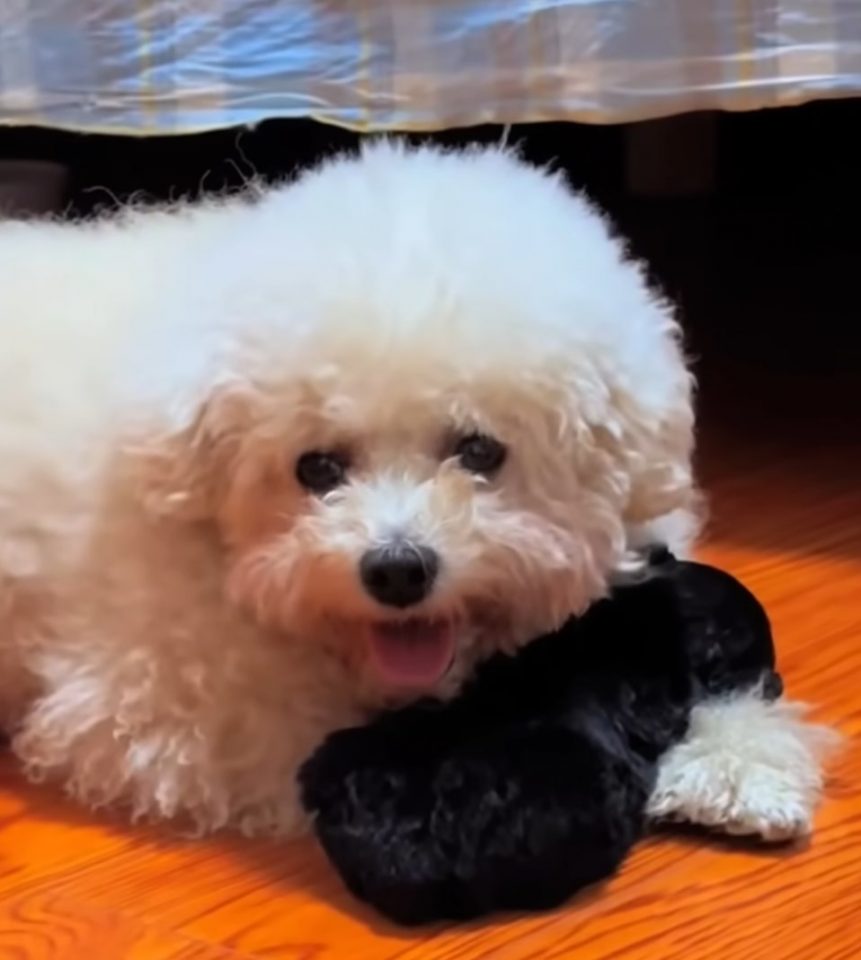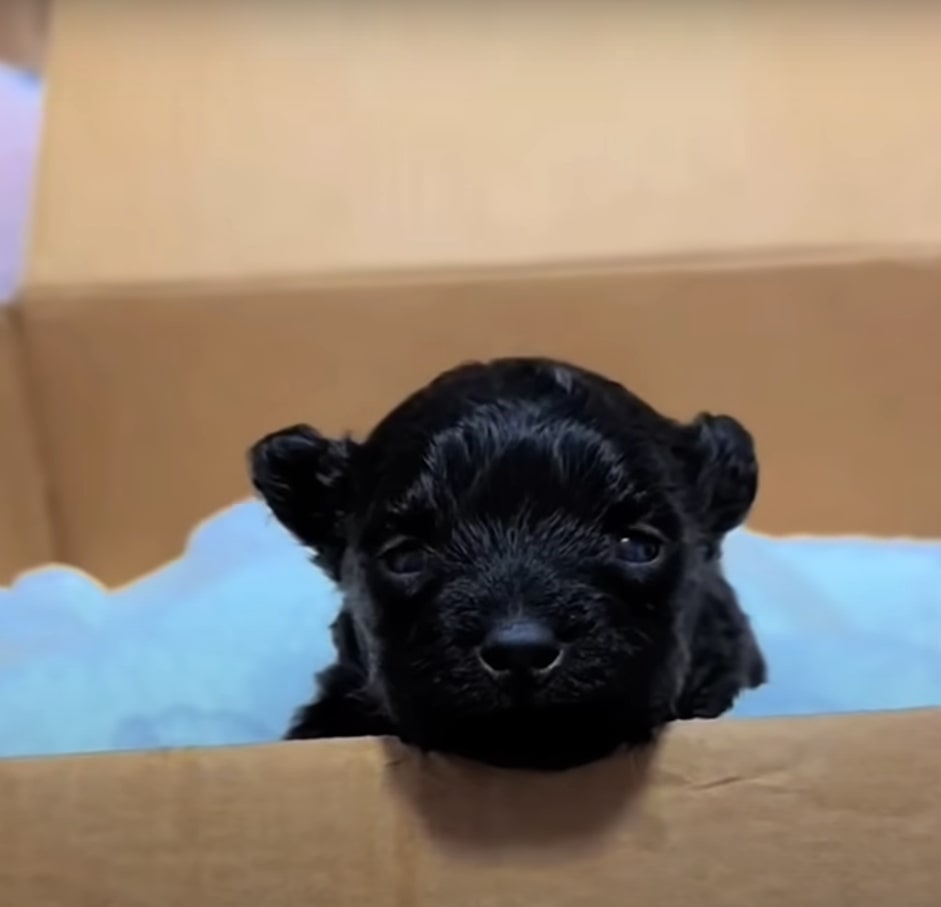For dog rescuers, seeing these tiny creatures get abandoned in various places is an everyday thing. So many owners leave their companions to fend for themselves in inhumane conditions that it is almost completely common to find them in the weirdest places.
But, just when they think they’ve seen it all, an act of cruelty shocks them.
One man was taking out the trash outside his home when something stopped him. He heard a high-pitched scream that appeared to be coming from the trash can. When he looked a little closer, he came to a shocking realization.
A Shocking Discovery

When he took a closer look, the man found a helpless, one-week-old puppy crying loudly in the garbage. He was left there by a heartless person, with no fighting chance.
The pup’s body was soaked and he smelled really bad from all the garbage that surrounded him. He tried hard to crawl out of it, but he was just too small to do anything.
All he could do was cry for his lost momma and wait for someone to notice him.

Almost half of his fur was covered with the waste, which left the man heartbroken. He just couldn’t believe that someone would do such a cruel thing to a puppy, and he immediately rushed into action.
He brought the puppy home, where he made him a warm, temporary shelter in a cardboard box.
The harsh reality was that the pup’s life was on the edge. He required care around the clock and feeding every two hours, but the man was determined. From that day on, he decided never to let go. And, his recovery started…
The Road To Recovery

Fed with formula, the puppy received the much-needed nutrients for his proper development. During the first couple of days, he was so hungry and emaciated that he practically drank the whole bottle within the first ten minutes.
Then, the signs of progress started to show.
After only a few days, the pup slowly started to crawl, and his loud cries stopped. He comfortably lay in his improvised bed and slept, as if his past had never happened.

A couple of days later, the man introduced the pup to his female dog. The sad news was that the dog had just lost her litter, and she was still coping with the tragedy. She was completely heartbroken and shut down, but then, a miracle happened!
Once she saw a puppy crawling up next to her fur, she warmed up. He became the baby she never had, and she immediately embraced him as one of her own.

He seemed so happy and enthusiastic about life that he immediately sprung into action. As soon as he started crawling, the pup showed who the boss of the house was. Next to his doggo and cat siblings, he was the most mischievous one!

The man was just so happy that the pup made it through. And, he knew that within months, he’d get the chance to adopt basic doggo manners.
For now, the entire family focuses on enjoying their time together. Looking back at the past, the man couldn’t be more grateful for stumbling into his furry buddy that day, and now, they get to spend their whole life next to each other!
Ever noticed your furry companion scratching more than usual? Ticks could be the sneaky culprits behind your dog’s discomfort. These tiny, troublesome creatures can easily go unnoticed, nestled deep in your pup’s fur. Understanding what ticks look like on dogs is essential for every pet owner. Imagine a small, dark speck moving amidst your dog’s coat, potentially causing irritation and transmitting diseases. As a responsible pet parent, being able to identify these pesky parasites is crucial for your dog’s well-being. So, let’s take a closer look at the world of ticks and how they might be affecting your four-legged friend.
Understanding Ticks on Dogs
Ticks are small external parasites that feed on the blood of animals, including dogs. They have eight legs and can vary in color and size depending on their species and life stage. Here’s what ticks look like on dogs:
- Size and Color: Ticks can be as small as a poppy seed or as large as a pencil eraser. They come in various colors like brown, black, or reddish-brown, making them sometimes hard to spot on your dog’s fur.
- Body Structure: Ticks have oval or pear-shaped bodies when unfed, but they become engorged and balloon-like after feeding on your dog’s blood. This change in shape is essential for identifying them on your furry friend.
- Legs: As mentioned earlier, ticks have eight legs, which make them arachnids. These legs help them attach firmly to your dog’s skin while feeding.
- Head and Mouthparts: Ticks have a specialized mouthpart called a hypostome that allows them to anchor securely into the skin while feeding. It’s crucial to remove the tick entirely, including its head, to prevent any infection.
- Movement: Ticks don’t jump or fly but crawl onto hosts from grass, bushes, or other animals. They prefer warm and moist areas on your dog’s body, such as around the ears, between the toes, or in armpits.
Being able to recognize ticks on your dog promptly is crucial for their health and well-being. Regularly check your dog for these parasites, especially after outdoor activities, to ensure a tick-free furry companion.
Identifying Ticks on Your Dog
How to Spot Ticks on Your Dog:
- When checking your dog, focus on areas like the ears, neck, head, feet, and between toes.
- Run your hands gently over their fur, feeling for any small bumps or growths.
- Ticks can vary in size, from tiny nymphs (about 1mm) to engorged adults (up to 1cm).
- Engorged ticks can appear like small warts or skin tags.
Recognizing Tick Colors:
- Ticks come in different colors like brown, black, reddish-brown, or gray.
- Engorged ticks may look darker due to the blood they’ve consumed.
Understanding Tick Body Structure:
- Ticks have oval-shaped bodies that swell after feeding.
- Their bodies are flat until engorged, where they become rounded.
Examining Tick Legs:
- Ticks have eight legs at the front of their bodies, near their mouthparts.
- These legs help them crawl and attach firmly to your dog’s skin.
Noticing Tick Head and Mouthparts:
- The tick’s head is located at the front of its body, near the attachment site.
- Their mouthparts, including barbed feeding structures, pierce the skin to feed on blood.
Preferred Tick Locations on a Dog:
- Ticks prefer warm, hidden areas like the groin, armpits, ears, and around the eyes.
- Check these spots thoroughly, as ticks like to latch onto softer skin.
Takeaway:
Regularly examining your dog for ticks is crucial to spot and remove them promptly, ensuring your furry companion stays healthy and happy.
Removing Ticks Safely
When it comes to removing ticks from your furry friend, it’s crucial to do it safely to avoid causing harm or discomfort. Here’s how you can safely remove ticks from your dog:
Gather Your Supplies
Before you start, make sure you have all the necessary supplies on hand. You will need fine-tipped tweezers, rubbing alcohol, gloves, and a small container to dispose of the tick.
Prepare for Removal
Put on your gloves to protect yourself from any potential pathogens. Dab some rubbing alcohol on the tweezers to disinfect them before use.
Grasp the Tick
Using the tweezers, grasp the tick as close to your dog’s skin as possible. Be gentle but firm to ensure you get a good grip on the tick.
Remove the Tick
Pull the tick straight out with steady pressure. Avoid twisting or jerking motions, as this can cause the tick’s mouthparts to break off and remain in your dog’s skin.
Dispose of the Tick
Place the tick in the container with rubbing alcohol to kill it. Avoid squishing the tick with your fingers to prevent any potential transmission of diseases.
Clean the Area
After removing the tick, clean your dog’s skin with rubbing alcohol or soap and water. Monitor the area for any signs of infection.
Monitor Your Dog
Keep an eye on your dog for the next few weeks for any signs of tick-borne illnesses. If you notice any unusual symptoms, contact your veterinarian immediately.
Ensuring you know how to safely remove ticks from your dog is essential for their health and well-being. Regularly check your dog for ticks, especially after outdoor adventures, to catch and remove them promptly.
Preventing Tick Infestations in Dogs
To protect your furry friend from tick infestations, follow these essential tips:
1. Tick Control Products
Use vet-recommended tick prevention products like spot-on treatments, sprays, collars, or oral medications to keep ticks at bay. These products can be highly effective in preventing tick infestations.
2. Regular Grooming
Make grooming a routine habit to check for ticks on your dog’s coat. Brushing and combing your dog regularly can help you spot ticks early before they become a problem.
3. Yard Maintenance
Keep your yard tidy by mowing the grass regularly, clearing debris, and trimming bushes to reduce tick habitats. This simple step can help lower the chances of ticks latching onto your dog.
4. Avoid Tick-Prone Areas
When taking your dog for walks or hikes, try to avoid heavily wooded or grassy areas where ticks are more prevalent. Stick to cleared paths to minimize the risk of tick exposure.
5. Check Your Dog After Outdoor Activities
After outdoor adventures, check your dog thoroughly for ticks. Pay close attention to areas like the ears, neck, head, feet, and between toes where ticks are commonly found.
6. Consult Your Vet
Regular check-ups with your veterinarian can help monitor your dog’s health and ensure they are protected against ticks. Your vet can recommend the best tick prevention strategies tailored to your dog’s specific needs.
Conclusion
That’s all you need to know about spotting ticks on your furry friend. By understanding their appearance and where they like to hide, you can keep your dog tick-free. Remember to check your dog regularly and remove ticks safely. Using preventive measures and seeking advice from your vet can help protect your pet from tick-related issues. Stay vigilant and give your doggo the best care possible!
Frequently Asked Questions
How can I identify ticks on my dog?
Ticks are often dark in color and vary in size, resembling a small bump or mole on your dog’s skin. Common areas to check include the head, ears, neck, feet, and underbelly.
How do I safely remove ticks from my dog?
Use fine-tipped tweezers to grasp the tick as close to the skin as possible. Pull upward with steady, even pressure. Clean the bite area and your hands thoroughly after removal.
What are some key tips for preventing tick infestations on my dog?
Use tick control products recommended by your vet, regularly groom your dog, maintain your yard, avoid tick-prone areas, check your dog after outdoor activities, and seek advice from your vet for tailored prevention strategies.
[no_toc]

Hey there, I’m Janet Brooks, a dog-loving student from California. I’m all about helping pups in need, especially those without homes. Me and my awesome friends work together to give shelter and love to stray dogs. Oh, and I also write blogs about dogs to share helpful info.